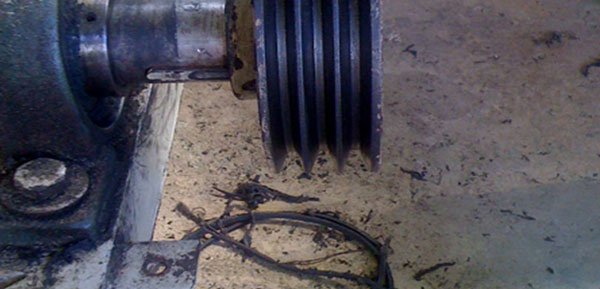On a process plant, where back-up equipment is available, it is imperative that any maintenance carried out is scheduled as far away from the back-up unit as possible.
The following article is an example of why proper maintenance planning and scheduling is instrumental in keeping component wear-out manageable and predictable.
The night the sparks flew (literally)
I once worked on a plant that had 2 process trains. Each train was a mirror to the other: 1x SAG mill, 2x Ball mills, a cyclopack, 2x cyclone feed pumps (1x duty, 1x standby) and 2 CIL tank feed pumps. It had been a quiet shift. All the daily tasks had been completed, the guys were leaving to go home, I was packed and making my last walk around the plant to make sure all was well.
As I passed by SAG 1 sump, I became aware of a different noise. Higher pitched than usual, my eyes were drawn to the duty cyclone feed pump. Suddenly a shower of sparks erupted from the pump, the noise became a scream, a sudden bang, then silence. The acrid smell of melted rubber hit my nose. I looked at the base of the cyclone feed pump and could see the Vee-belts hanging limply, as well as a few pieces of belt that had escaped the guarding.

I had a couple of guys standing with me, who had also been drawn to the scream and loud bang as they were leaving the plant. I directed them to get tools and vee-belts from the satellite store, as the process guys started up the standby pump. As it was only a vee-belt failure, we comforted ourselves as we removed the guarding and started to replace the burned belts.
Then, right next to us, the now-duty pump started to scream.
Sparks flew from out of the guarding, then a big bang and the pump stopped. Melted rubber smell assaulted us again and the vee-belts were again visible, limply hanging below the guarding. We quickly removed the guarding of the first pump, replaced the belts, carried out a rudimentary alignment and re-started.
We then moved to the second pump, replaced the belts, re-fitted the guarding, just as the duty pump started screaming and producing the same sparks as before. Another loud bang and silence, again.
Each pump was running with 6x vee-belts, of which our satellite store had 18 available. All 18 were used in the space of a couple of hours.
Assessing the failure
Looking at the pulleys on the now stationary pump, it was obvious what the issue was. The vee belts had bottomed out in the grooves, causing the belts to disintegrate as the drive was transmitted from the bottom of the belt as well as the Vee. The local supervisor ushered me away to go and check on the warehouse stock excel spreadsheet, whilst he oversaw the refitting of the belts.
Checking stock levels, I discovered we had 6 belts left on site. I also made a few calls and discovered that we had no spare pulleys (either pump or motor) or taper locks and nothing on order. Making my way back down to the pumps, I discovered it back running, quietly as usual.
Suddenly a scream, sparks, loud bang and silence, this time from SAG 2 cyclone feed pump. The standby pump was ran-up and seemed to be okay. Removing the guards, we discovered exactly the same; the pulleys had worn out. Luckily these two pumps used longer belts, and we had 6 ready to go in the satellite store.
The band-aid solution
By some miracle, the pumps ran through the night. We then went on a crazy search for Vee belts. Too heavy duty for the mobile guys to use, we raided the local market, where, whilst we found a lot of “contraband” items from the mine, no useful belts.
I ordered pulleys, belts and taper locks. Due to the cost of “hot-shotting” them to site, I was only allowed to have 1 set of pulleys and taper locks flown in with a decent amount of Vee-belts (6 weeks away), the other pulleys and belts would have to come by road (6 months away).
We had to run for the 6-weeks with 6 spare vee belts, 4 sets of worn-out pulleys and absolutely no way to get anything to us sooner.
Preventing future failures
By some local magic (whether it was luck or some other means), we didn’t suffer another breakdown caused by pulleys, we replaced all when the new units arrived and we ensured that we had at least 1 spare set of pulleys in the warehouse at all times.
If we had a critical spares list, or were tracking the run times of the pumps (actually any piece of equipment), we would have known we were due a major breakdown:
- The pumps were always run to failure, but in this case, every piece of equipment was.
- No routine inspections were done on anything, in this instance a simple check with a vee-belt gauge would have given us advanced warning of the pending failures.
- No-one had thought about spacing out the pulley replacement, so 4 pumps wouldn’t have been likely to break-down at the same time with the same issues.
- Indeed, with no full time planner, there was no real planning done, with most replacements prompted by memory, rather than time or tons.
Had we implemented proper maintenance planning and scheduling, we would have replaced the pulleys so as not to have multiple failures, and we would have been ensuring the standby pumps were ran up weekly so we knew they were reliable.
Do you recognise any of these issues from within your own organisation? If so, consider reading into how to better manage your critical spares, or seeking maintenance planning and scheduling training for your team, to ensure you don’t suffer similar equipment breakdowns.
